ChicGeek Comment Fashion of Looking Like ‘Cool Crap’
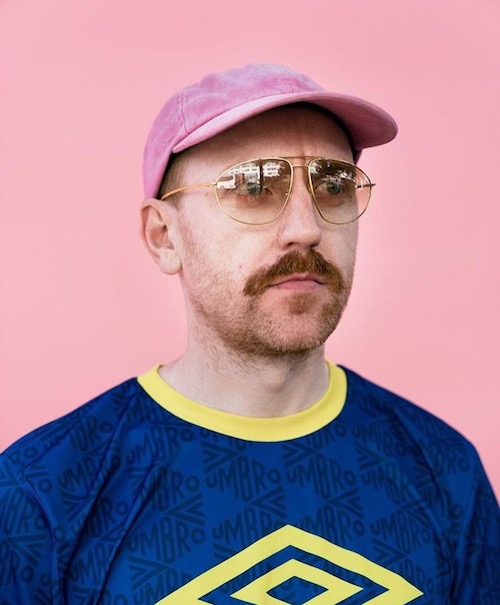 I recently went to Berlin, for their fashion week, which is dominated by two trade shows, Seek and Premium. I know Berlin is the city of the young hipster wanker and far from the bourgeois idea of fashion. Always has been. But, watching a young guy in adidas trackie bottoms, an old tour T-shirt tucked in and a fake looking GG monogrammed Gucci hat, it’s pretty clear that fashion, ATM, is looking like ‘cool crap’.
I recently went to Berlin, for their fashion week, which is dominated by two trade shows, Seek and Premium. I know Berlin is the city of the young hipster wanker and far from the bourgeois idea of fashion. Always has been. But, watching a young guy in adidas trackie bottoms, an old tour T-shirt tucked in and a fake looking GG monogrammed Gucci hat, it’s pretty clear that fashion, ATM, is looking like ‘cool crap’.
Pioneered here, but spreading: it’s about found, second-hand, vintage, charity and everything that is the opposite about looking expensive and ‘designery’.
Left 'Pensive Crap' at Seek in Berlin - Cap - J Crew, Sunglasses - Vintage Gucci, Top - Umbro
It’s been coming a while, and it’s something the fashion industry struggles with, because making something shiny and new is what they are used to. Plus, why buy something brand new when you want it to look old?
 It’s about mass produced old items looking old. This isn’t the Gucci idea of decadent vintage. That’s over.
It’s about mass produced old items looking old. This isn’t the Gucci idea of decadent vintage. That’s over.
I know Italian brands have been doing ‘pre-distressed’ for donkey’s, and it’s always looked a bit crap. Ripped jeans, anybody? But, it was interesting to see brands, such as Pony and Valsport, doing options of trainers looking like you’ve been wearing them for months.
Right - Pony distressed for SS18
Even if you buy something new, you style it in a way which looks old and not cared about. Maybe that’s why we’re seeing collaborations such as Louis Vuitton and Supreme in order for these brands to look less expensive, even though the prices say something else.
Some brands only know how to do new and this is leading to people raiding wardrobes and rediscovering things they used to wear or asking parents for their old sportswear. Hoping they've hoarded it.
Menswear is really experimenting in this area and the worry of looking bad is over, as that’s really the point. It’s about looking like an America tourist from 1985 or a post-Soviet Russian, aping western brands, circa 1994.
Could be a hard sell, or no sell at all, and this certainly won’t help the struggling fashion industry.
Below - Valsport SS18 worn look, Never too old for Vetements SS18
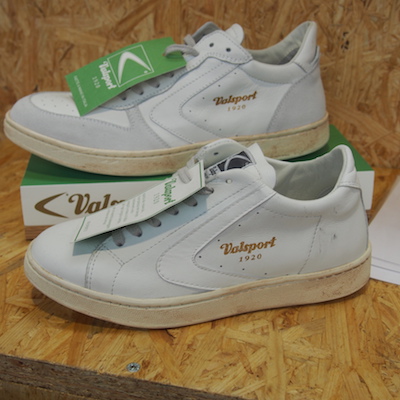

Menswear Trend New Balls, Please!
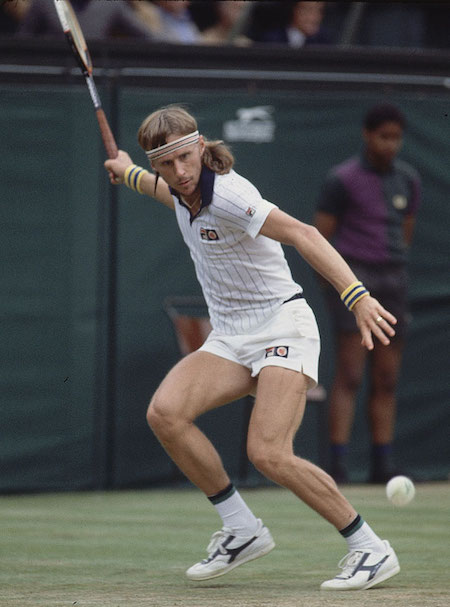 You’ve probably realised I’m a bit obsessed with Fila Vintage right now. I can't get enough of their faithful and authentic recreations of their 70s and 80s archive. I was sporting one of their striped T-shirts, like the one Bjorn Borg is wearing, pictured left, at the ponds on Hampstead Heath over the weekend and one of the fellow swimmers said I looked like the 118 guy! Yes! This is definitely the look you should be going for!
You’ve probably realised I’m a bit obsessed with Fila Vintage right now. I can't get enough of their faithful and authentic recreations of their 70s and 80s archive. I was sporting one of their striped T-shirts, like the one Bjorn Borg is wearing, pictured left, at the ponds on Hampstead Heath over the weekend and one of the fellow swimmers said I looked like the 118 guy! Yes! This is definitely the look you should be going for!
With Wimbledon starting this week, it’s time to get involved with the short short and get your inspiration from two of the most iconic of tennis stars. A favourite of the Bjorn Borg/McEnroe era, the white short short is the go to for the man who wants to give his thighs a little bit of breathing space.
Fila has been reselling these shorts for a few years now, but it feels so right. Perfect for holiday, it shows you don't take yourself too seriously in a Wes Anderson type sports outfit way. The headband is optional. #legsout
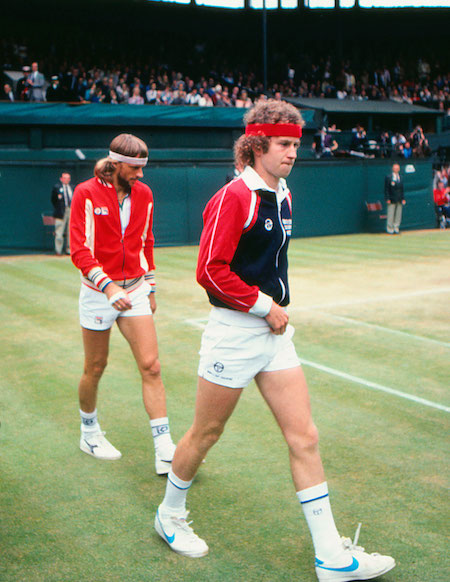
Below - Fila Vintage - MK2 Settanta Shorts - £39 from www.80scasualclassics.co.uk
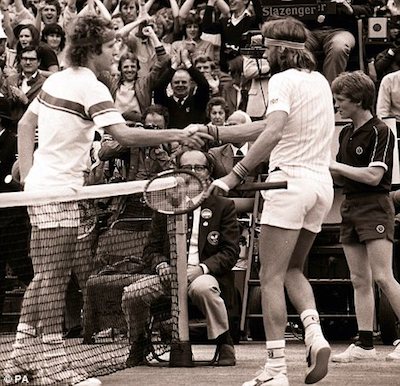
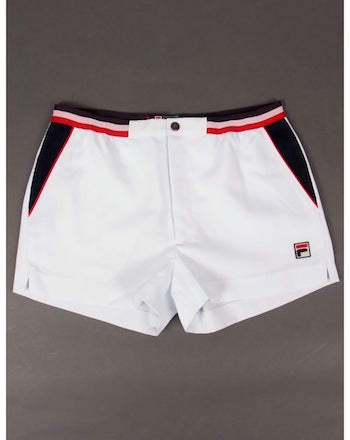
ChicGeek Comment Pound Wars Poker Face
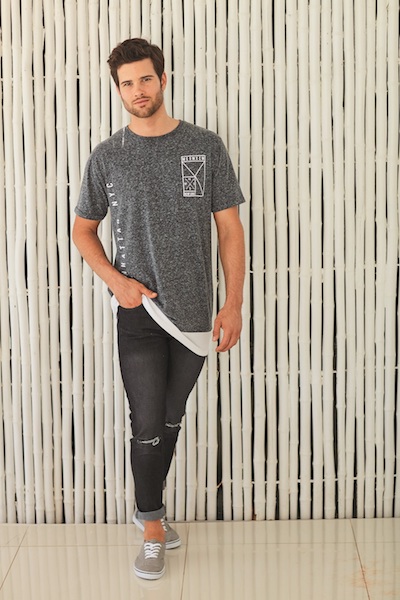
I think we all know how competitive it is at the lower end of the clothing market. But, it was an e-mail, a few weeks ago, from Marks & Spencer that really summed up where we are. It was announcing their new range of men’s ‘Quick Dry Swim Shorts’, all pretty standard for this time of year, but it was the price that caught my eye. A bargain £10! This is cheaper than Topman, cheaper than River Island and even New Look. It’s certainly cheap for M&S and, then, you realise all the retailers are busy racing to the bottom.
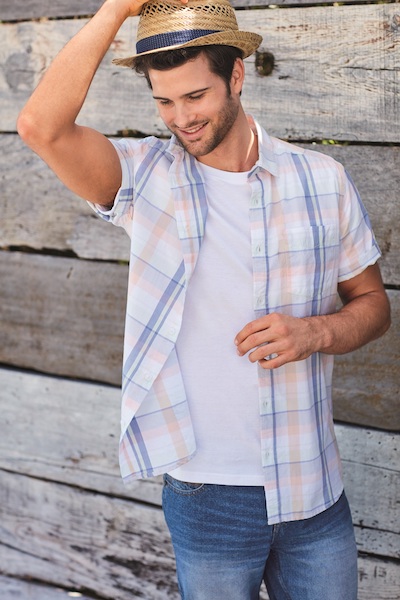 What this means is, in order for those companies to make money, they need to shift a hell of a lot of product. British retailers are currently playing a game of poker, holding their hand i.e. keeping prices low, waiting for their competitors to fold.
What this means is, in order for those companies to make money, they need to shift a hell of a lot of product. British retailers are currently playing a game of poker, holding their hand i.e. keeping prices low, waiting for their competitors to fold.
Left - Pep&Co at Poundland SS17
But, if this game wasn’t tough enough, new competition is entering the market which will only increase pressure on those margins and unsustainable volumes.
For example, Poundland has entered the clothing market. Their in-house brand, Pep&Co, launched into stores in March this year.
They've already opened over 50 Poundland shop-in-shops with another 50 or so planned for the second half of 2017. The chain, which was bought by the South African group Steinhoff International, expects to put Pep&Co clothing outlets in up to 200 of its 850 stores over the longer term.
Pep&Co was founded by Andy Bond, who once ran Asda’s George clothing label, with backing from the South African tycoon and Steinhoff shareholder Christo Wiese.
The first shop opened in Kettering, Northamptonshire, in July 2015 and the chain opened its first 50 stores in less than two months.
They sell a full range of menswear, with 90% of the range under £10. Example lines are denim from £5 and 100% cotton fashion Tees from £3.
If people are wearing Poundland, it means they aren’t wearing another brand. This isn’t about sneering at this end of the market, it’s about wondering who will go out of business first. It's unsustainable.
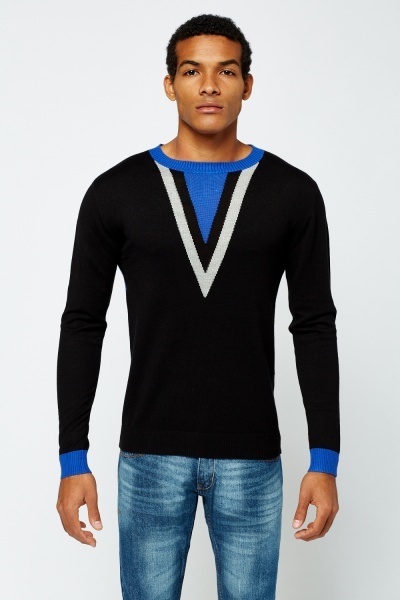 The market is saturated and these business models only work if you can order huge volumes and shift it fast.
The market is saturated and these business models only work if you can order huge volumes and shift it fast.
This is new competition for all the supermarket brands plus Peacocks and Primark and traditional high-street retailers like M&S and Debenhams are more keenly pricing their offering. Add discount brands such as TK Maxx and the neverending discounts and sales and you have an environment that is harder to make profit in.
Consumers are being squeezed with higher inflation and low wages and are generally satisfied with cheaper clothes. They can't or don't want to pay more.
Then add the internet, with Boohoo offering bargain fashion-led clothing and websites such as EverythingFivePounds, where everything is, literally, five pounds, and you have the perfect storm to implode some of the giants of the British high-street. Arcadia, the owner of Topman, is already seeing revenues fall and Topman is looking increasingly expensive against the competition.
In this game of pound wars poker, who will run out of chips and fold first?
Left - Louis Vuitton? No, Everythingfivepounds - £5
Hot List The Porter Nobis
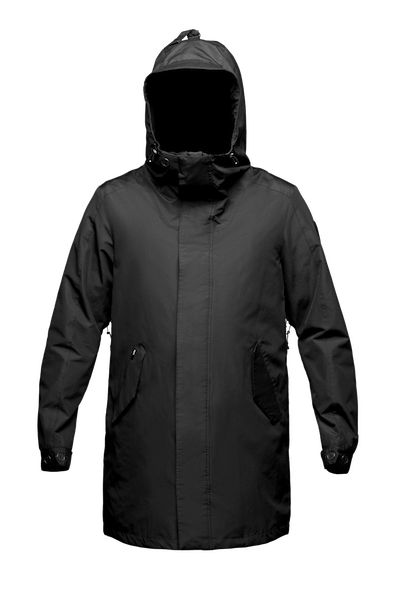
There’s Nobis-ness like snow business! Well, actually there is. Known for its technical winter parkas and a relative newcomer to the world of luxury outdoors, this Canadian brand was founded just over a decade ago. Nobis - meaning latin for ‘us’ - was founded by Robin Yates, a keen huntsman and personally involved in testing all new jackets, material and details, regularly sleeping out on frozen lakes and riding skidoos across the tundra in Nobis jackets.
But, while its signature maybe its fur-trimmed winter coats, Nobis also do more lightweight and waterproof options for this time of year.
The standout, for this season, and what I'm most excited about is the handsome ‘Porter’. ‘Embrace’ membrane fabrics ensure waterproofing, windproofing and breathability, while zipped underarm vents, super-strength magnetic fastenings and seam-sealed construction ensure you stay warm and dry.
The adjustable hood has a moulded in-peak wire to stop it flapping about and is perfect for when those British days become downpours and you want something reliable, understated and stylish.
Left & Below - Nobis - The Porter - £450
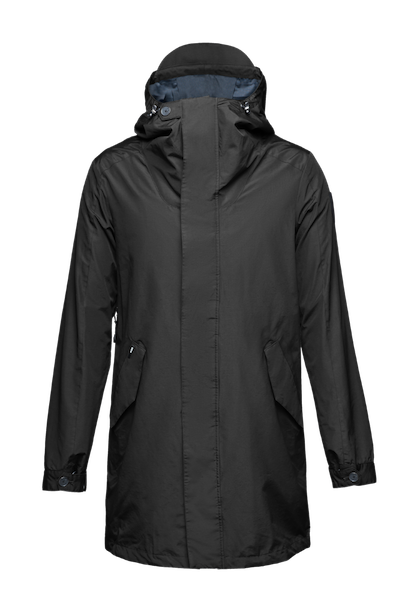
Tribute Jack O’Neill
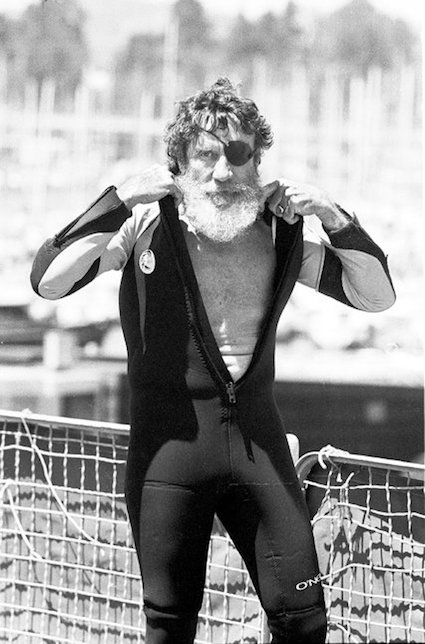
I’d heard of his surname, obvs, but I didn’t know the man behind the brand until he died recently and I read an obituary on the flight over to the recent Pitti Uomo. Jack O’Neill’s life is a fascinating story of the birth of surfing and how it came to influence 20th century style and grew to become a huge, billion dollar industry.
Left - Jack started to wear his eye patch in the 1970s after his surfboard hit his eye
“I just wanted to surf longer”, was the inspiration for the eye patch-wearing surfing pioneer who helped to invent the wetsuit.
Before the advent of the wetsuit, O’Neill and his fellow surfers had been braving the Pacific by wearing long underwear or sweaters coated with oily sealant, or by stuffing flexible polyvinyl chloride into their swimming trunks.
He was turning blue from ocean temperatures that even on balmy summer afternoons might barely flirt with 60 degrees.
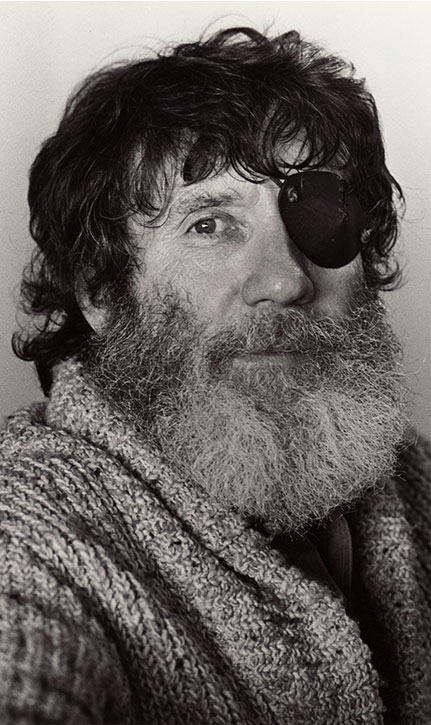 O’Neill’s wetsuit discovery came about after he moved with his wife to San Francisco’s Ocean Beach neighbourhood in the early 1950s.
O’Neill’s wetsuit discovery came about after he moved with his wife to San Francisco’s Ocean Beach neighbourhood in the early 1950s.
“All my friends said, ‘O’Neill, you will sell to five friends on the beach and then you will be out of business,’” he would remark, according to his family.
By one account, a friend, Harry Hind, told him about a compound that had been developed by DuPont about two decades earlier for foam rubber life vests. By another account,O’Neill said a light went off when he examined the rubber undercoating on the carpet of a DC-3 commercial airliner.
Whatever the inspiration, he began developing suits for surfing and bodysurfing, originally covering just the torso. They were not waterproof, however. Rather, the suit trapped a thin layer of water, warmed by body heat, between the neoprene and the skin.
In San Francisco he opened one of the area’s first surf shops, but in 1959 moved his growing family 75 miles (120km) south to Santa Cruz, where he opened his second shop to cater to the city’s growing surf scene.
By 1960 Mr. O’Neill was laminating an elastic nylon jersey lining to the neoprene foam to prevent it from tearing, and to make it easier to put on. He made his first full-length model within a decade.
He began wearing a black eye patch after his surfboard hit his left eye while riding a wave in the 1970s.
By the 1980s, O’Neill had become the world’s largest recreation wetsuit designer and manufacturer and the O’Neill surf brand had reached Australia, Europe and Japan.
While surfing brands have taken a hit during this century, the name is known the world over for an escapist lifestyle that is continually referenced and returned to. There's something very romantic and healthy about the early Californian surf culture and it's worth noting this pioneer lived to the ripe old age of 94 despite the amount of UV rays he was exposed to.
More...
Trend It's A Wrap!
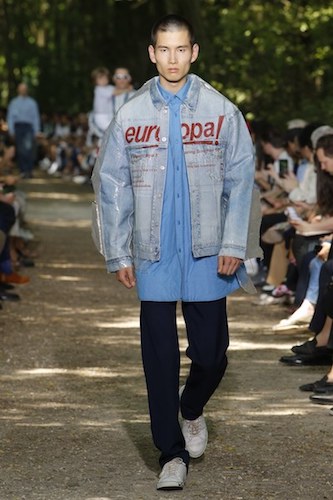
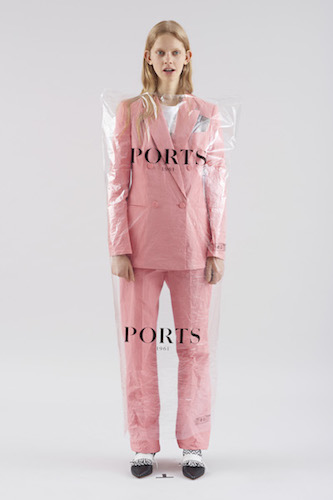
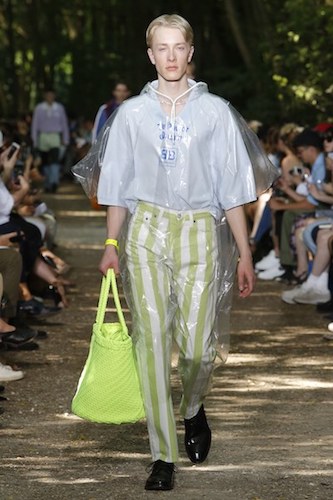 Straight from the dry cleaners, the trend for boxfresh, cellophane wrapped and pristine fashion hit its zenith at the recent Paris shows.
Straight from the dry cleaners, the trend for boxfresh, cellophane wrapped and pristine fashion hit its zenith at the recent Paris shows.
Make like your granny's sofa and add a clear coat for SS18. Perfect for public transport!
From Left - Balenciaga SS18, Ports 1961 Resort 2018, Balenciaga SS18
Hot List The Memphis Top
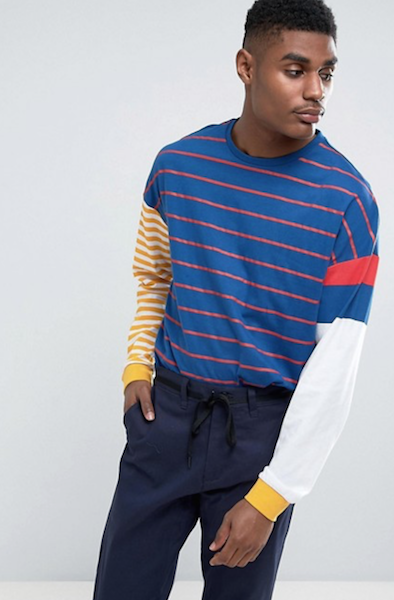 The current obsession with the eighties shows no signs of abating and the Italian Memphis group of designers, from that period, have come to represent and define an era which was a riot of bold primary colours and clashing patterns. This is the age of MTV and Beetlejuice, a time when post-modernism was new and Timmy Mallett was a style icon. Okay, well, maybe not the last bit!
The current obsession with the eighties shows no signs of abating and the Italian Memphis group of designers, from that period, have come to represent and define an era which was a riot of bold primary colours and clashing patterns. This is the age of MTV and Beetlejuice, a time when post-modernism was new and Timmy Mallett was a style icon. Okay, well, maybe not the last bit!
Fashion is taking inspiration from that time and the furniture has become increasingly collectible and expensive. The café, at the recent LFWM, had a few pieces to really cement its status.
This top from ASOS is pure Memphis, with its strong clashing colours and asymmetric design, and at £16 is far from those escalating 'modern classic' prices.
Left & Below - ASOS - £16
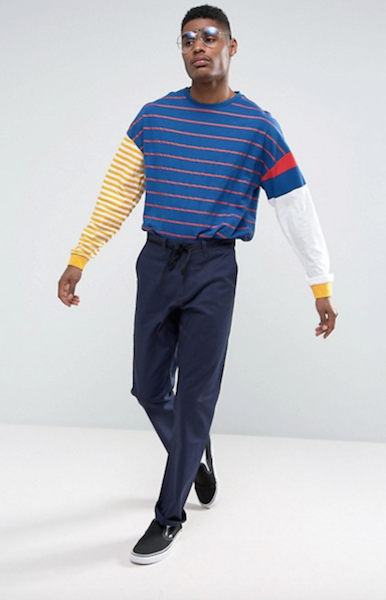

Above - Collection of 1980s Italian Memphis furniture